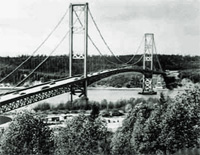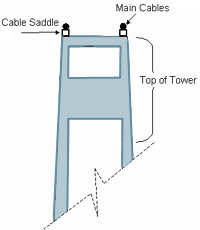Tacoma Narrows Bridge history - Bridge - Suspension bridge basics
Suspension Bridge Basics
What's here?

1950 (Current) Bridge, WSDOT
Used For Long Spans
Suspension bridges are amazing, wonderful structures. They appear almost fragile, viewed from a distance. Yet, they are very strong and nowadays are the world's longest bridge type.
They are used for the longest crossings. Typical lengths for spans of this type range from 2,000 feet to 7,000 feet. The longest suspension bridge in the world is Akashi Kaikyo Bridge in Japan. Its center span measures an astounding 6,527 feet, and the bridge's total length is 12,828 feet.

Akashi Kaikyo - 12,828'

Golden Gate - 8,981'

Tacoma Narrows - 5,979'

Brooklyn - 3,460'
They All Move!
Because they are relatively light and flexible, suspension bridges are all susceptible to wind. They vibrate and move, both vertically (up and down) and laterally (sideways). The challenge for the bridge engineer is to keep this motion within safe limits.
The most vulnerable part of a suspension bridge is the suspended roadway, or deck. Do you have gephyrophobia?
Engineers designed the 1940 Narrows Bridge to withstand winds up to 120 mph, but it collapsed in a wind of only 42 mph. Why?
The Parts

Illustration of basic suspension bridge part
A suspension bridge does just what the name implies. The deck, or roadway, is suspended by large cables that are secured at each end and pass over the tops of high towers.
The basic parts of a typical suspension bridge fall into two categories, "superstructure" and "substructure." The superstructure (super = above) is composed of a deck (or roadway, or girder), two towers, and the main suspension cables. The substructure (sub = below) is composed of the piers (caissons, or tower foundations) in the middle of the span that support the towers, and the anchorages (anchors) for the cables at each end of the bridge.
The deck, or girder, is where we drive or walk. It is continuous and may be a truss, or a box girder, or a plate girder.
Large anchors, or anchorages, at both ends of the bridge act as counter weights that hold the ends of the main cables. The anchorages are normally either a mass of concrete or solid rock. In the anchorage, the cables splay into separate strands to distribute the tension load evenly and safely.
The main cables stretch from one anchor over the tops of the tower and attach to the opposite anchorage. The cables are compacted strands of parallel wires carried back and forth across the water. At the anchorage, each cable strand wraps around a strand shoe. Each strand shoe connects to an eye-bar. The eye-bars are firmly cemented in the anchorage.

Illustration of tower and cable saddle
At the top of the towers each cable passes over a cable saddle. At the cable saddle the cable transfers the load from the cables to the tower.
The main cables are attached to the deck by suspender cables. These are sometimes also called "suspender ropes" and "hanger cables."
In a suspension bridge, the main cables suspend the deck (girder, roadway). Most of the bridge's weight (and any vehicles on the bridge) is suspended from the cables. The cables are held up only by the towers, which means that the towers support a tremendous weight (load).
The steel cables are both strong and flexible. This makes long span suspension bridges susceptible to wind forces. These days, engineers take special measures to assure stability ("aerodynamic" stability") to minimize vibration and swaying in a suspension bridge under heavy winds. The 1940 Tacoma Narrows Bridge is the world's most famous example of aerodynamic instability in a suspension bridge.